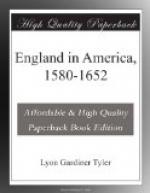The winter of 1607-1608 was terrible to the forty-five men who remained at Kennebec, where land and water were locked in icy fetters. Their storehouse took fire and was consumed, with a great part of the provisions, and about the same time President George Popham died. The other leader, Captain Raleigh Gilbert, grew discouraged when, despite an industrious exploration of the rivers and harbors, he found no mines of any kind. When Captain James Davis arrived in the spring, bringing news of the death of Chief-Justice Popham and of Sir John Gilbert, Raleigh Gilbert’s brother, who had left him his estate, both leader and colonists were so disenchanted of the country that they with one accord resolved upon a return. Wherefore they all embarked, as we are told, in their newly arrived ship and newly constructed pinnace and set sail for England. “And this,” says Strachey, “was the end of that northerne colony upon the river Sagadahoc."[12]
To the London Company, therefore, though slower in getting their expedition to sea, belongs the honor of the first permanent English colony in America. December 10, 1606, ten days before the departure of this colony, the council for Virginia set down in writing regulations deemed necessary for the expedition. The command of the ships and settlers was given to Captain Christopher Newport, a famous seaman, who in 1591 had brought into the port of London the treasure-laden carrack the Madre de Dios, taken by Raleigh’s ship the Roe Buck. He was to take charge of the commissions of the local council, and not to break the seals until they had been upon the coast of Virginia twenty-four hours. Then the council were to elect their president and assume command of the settlers; while Captain Newport was to spend two months in discovery and loading his ships “with all such principal commodities and merchandise there to be had."[13]
With these orders went a paper, perhaps drawn by Hakluyt, giving valuable advice concerning the selection of the place of settlement, dealings with the natives, and explorations for mines and the South Sea.[14] In respect to the place of settlement, they were especially advised to choose a high and dry situation, divested of trees and up some river, a considerable distance from the mouth. The emigrants numbered one hundred and twenty men—no women. Besides Captain Newport, the admiral, in the Sarah Constant, of a hundred tons, the leading persons in the exploration were Bartholomew Gosnold, who commanded the Goodspeed, of forty tons; Captain John Ratcliffe, who commanded the Discovery, of twenty tons; Edward Maria Wingfield; George Percy, brother of the earl of Northumberland; John Smith; George Kendall, a cousin of Sir Edwin Sandys; Gabriel Archer; and Rev. Robert Hunt.
Among these men John Smith was distinguished for a career combining adventure and romance. Though he was only thirty years of age he had already seen much service and had many hairbreadth escapes, his most remarkable exploit having been his killing before the town of Regal, in Transylvania, three Turks, one after another, in single combat.[15] The ships sailed from London December 20, 1606, and Michael Drayton wrote some quaint verses of farewell, of which perhaps one will suffice:




